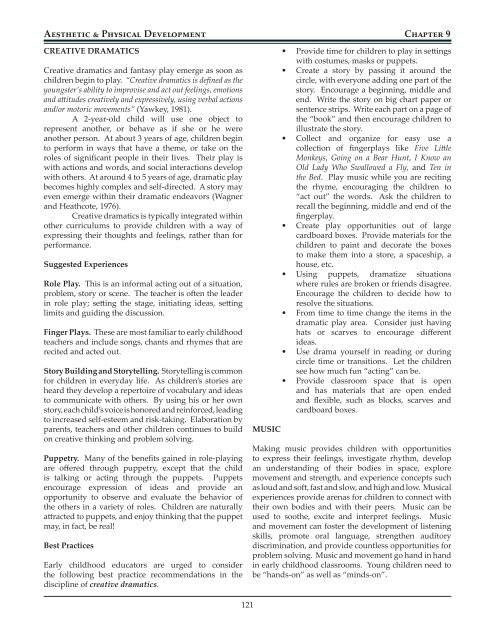Early Childhood - Connecticut State Department of Education
Early Childhood - Connecticut State Department of Education
Early Childhood - Connecticut State Department of Education
Create successful ePaper yourself
Turn your PDF publications into a flip-book with our unique Google optimized e-Paper software.
Aesthetic & Physical Development Chapter 9<br />
CREATIVE DRAMATICS<br />
Creative dramatics and fantasy play emerge as soon as<br />
children begin to play. “Creative dramatics is defined as the<br />
youngster’s ability to improvise and act out feelings, emotions<br />
and attitudes creatively and expressively, using verbal actions<br />
and/or motoric movements” (Yawkey, 1981).<br />
A 2-year-old child will use one object to<br />
represent another, or behave as if she or he were<br />
another person. At about 3 years <strong>of</strong> age, children begin<br />
to perform in ways that have a theme, or take on the<br />
roles <strong>of</strong> significant people in their lives. Their play is<br />
with actions and words, and social interactions develop<br />
with others. At around 4 to 5 years <strong>of</strong> age, dramatic play<br />
becomes highly complex and self-directed. A story may<br />
even emerge within their dramatic endeavors (Wagner<br />
and Heathcote, 1976).<br />
Creative dramatics is typically integrated within<br />
other curriculums to provide children with a way <strong>of</strong><br />
expressing their thoughts and feelings, rather than for<br />
performance.<br />
Suggested Experiences<br />
Role Play. This is an informal acting out <strong>of</strong> a situation,<br />
problem, story or scene. The teacher is <strong>of</strong>ten the leader<br />
in role play; setting the stage, initiating ideas, setting<br />
limits and guiding the discussion.<br />
Finger Plays. These are most familiar to early childhood<br />
teachers and include songs, chants and rhymes that are<br />
recited and acted out.<br />
Story Building and Storytelling. Storytelling is common<br />
for children in everyday life. As children’s stories are<br />
heard they develop a repertoire <strong>of</strong> vocabulary and ideas<br />
to communicate with others. By using his or her own<br />
story, each child’s voice is honored and reinforced, leading<br />
to increased self-esteem and risk-taking. Elaboration by<br />
parents, teachers and other children continues to build<br />
on creative thinking and problem solving.<br />
Puppetry. Many <strong>of</strong> the benefits gained in role-playing<br />
are <strong>of</strong>fered through puppetry, except that the child<br />
is talking or acting through the puppets. Puppets<br />
encourage expression <strong>of</strong> ideas and provide an<br />
opportunity to observe and evaluate the behavior <strong>of</strong><br />
the others in a variety <strong>of</strong> roles. Children are naturally<br />
attracted to puppets, and enjoy thinking that the puppet<br />
may, in fact, be real!<br />
Best Practices<br />
<strong>Early</strong> childhood educators are urged to consider<br />
the following best practice recommendations in the<br />
discipline <strong>of</strong> creative dramatics.<br />
121<br />
MUSIC<br />
• Provide time for children to play in settings<br />
with costumes, masks or puppets.<br />
• Create a story by passing it around the<br />
circle, with everyone adding one part <strong>of</strong> the<br />
story. Encourage a beginning, middle and<br />
end. Write the story on big chart paper or<br />
sentence strips. Write each part on a page <strong>of</strong><br />
the “book” and then encourage children to<br />
illustrate the story.<br />
• Collect and organize for easy use a<br />
collection <strong>of</strong> fingerplays like Five Little<br />
Monkeys, Going on a Bear Hunt, I Know an<br />
Old Lady Who Swallowed a Fly, and Ten in<br />
the Bed. Play music while you are reciting<br />
the rhyme, encouraging the children to<br />
“act out” the words. Ask the children to<br />
recall the beginning, middle and end <strong>of</strong> the<br />
fingerplay.<br />
• Create play opportunities out <strong>of</strong> large<br />
cardboard boxes. Provide materials for the<br />
children to paint and decorate the boxes<br />
to make them into a store, a spaceship, a<br />
house, etc.<br />
• Using puppets, dramatize situations<br />
where rules are broken or friends disagree.<br />
Encourage the children to decide how to<br />
resolve the situations.<br />
• From time to time change the items in the<br />
dramatic play area. Consider just having<br />
hats or scarves to encourage different<br />
ideas.<br />
• Use drama yourself in reading or during<br />
circle time or transitions. Let the children<br />
see how much fun “acting” can be.<br />
• Provide classroom space that is open<br />
and has materials that are open ended<br />
and flexible, such as blocks, scarves and<br />
cardboard boxes.<br />
Making music provides children with opportunities<br />
to express their feelings, investigate rhythm, develop<br />
an understanding <strong>of</strong> their bodies in space, explore<br />
movement and strength, and experience concepts such<br />
as loud and s<strong>of</strong>t, fast and slow, and high and low. Musical<br />
experiences provide arenas for children to connect with<br />
their own bodies and with their peers. Music can be<br />
used to soothe, excite and interpret feelings. Music<br />
and movement can foster the development <strong>of</strong> listening<br />
skills, promote oral language, strengthen auditory<br />
discrimination, and provide countless opportunities for<br />
problem solving. Music and movement go hand in hand<br />
in early childhood classrooms. Young children need to<br />
be “hands-on” as well as “minds-on”.

















